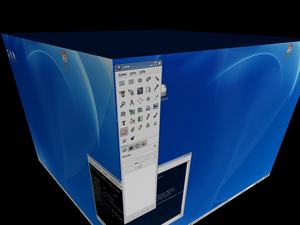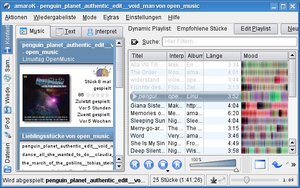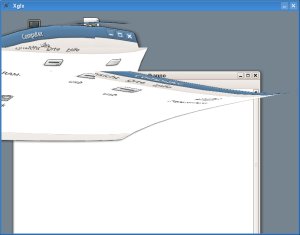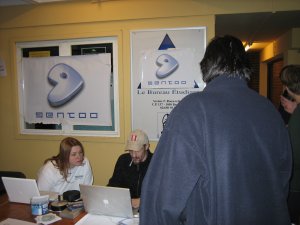Wednesday, June 21. 2006
Compiz on AIGLX
 Another update from the X-funky-and-cool-front: With some Patches from Kristian Høgsberg, I got compiz running with aiglx.
Another update from the X-funky-and-cool-front: With some Patches from Kristian Høgsberg, I got compiz running with aiglx.For those who don't know: Compiz is a combined window/composite manager that was released together with xgl earlier this year. aiglx is another approach to get 3D-accelerated Desktops on Linux/Xorg.
I've merged the appropriate (very experimental stuff, big fat warning!) gentoo packages into my overlay. For all non-gentooers: You are on your own, but you can grab Kristian's patches here. Update: Kristian told me that Fedora Rawhide users are also lucky.
You can get it with
svn co http://svn.hboeck.de/xgl-overlay
(It's still called xgl-overlay, although it should probably be named »various-funky-x-stuff« or so, but I was too lazy to rename it)
To install it, check it out like above, put the path into your PORTDIR_OVERLAY-var in make.conf. Then re-merge libdrm, mesa, xorg-server and compiz (all ~x86). You can also merge experimental libcm/metacity-packages (metacity with 3d-effects), therefore add xcomposite to your USE-flags and merge metacity-2.15.5.
To start compiz on aiglx (that means »normal« X):
LIBGL_ALWAYS_INDIRECT=1 compiz --replace --strict-binding move resize minimize place decoration wobbly cube rotate scale switcher zoom &
gnome-window-decorator
(replace plugins with anything you want, the LIBGL-var and strict-binding are required for running in aiglx, this should be automatically detected soon)
For metacity use:
USE_WOBBLY=1 metacity --replace
As before, there is still a package for xgl, so you now can try both.
Posted by Hanno Böck
in Computer culture, English, Gentoo, Linux
at
01:27
| Comments (48)
| Trackback (1)
Sunday, May 7. 2006
File dialogs in linux desktop environments
When I was asked in the past what linux desktop lacks I kept on telling that we need a way to have a more common look and feel among several desktop environments. Opening a gtk/gnome-app shouldn't look weird in kde, same thing with opening a qt/kde-app in gnome. Dialogs for files, printing etc. should look common. You can discuss hours if the button-order should be »Ok«/»Cancel« or »Cancel«/»Ok«, but it's definitely the worst if this changes from app to app.
Today I found this little tool called KGtk, which (partly) does what I want. It's a wrapper around gtk-apps to call the kde file open dialog. It also contains the same thing for qt apps (that don't use kdelibs).
Using it is quite trivial, just start
kgtk-wrapper.sh [somegtkapp]
or
kqt-wrapper.sh [someqtapp]
I really like it, because there are some gtk-apps I don't want to miss (especially gimp), but I think the new gtk fileselector is really a sin of usability.
While this is (cited from webpage) »a quick-and-dirty LD_PRELOAD hack«, it imho shows exactly how it should work. The freedesktop.org standardisation is a very good thing, but it has to go much further. We need something like »app tells DE to open a file-open dialog« instead of »app opens it's file dialog«. We need the same thing for printing, iconsets, button-order and probably much more.
Today I found this little tool called KGtk, which (partly) does what I want. It's a wrapper around gtk-apps to call the kde file open dialog. It also contains the same thing for qt apps (that don't use kdelibs).
Using it is quite trivial, just start
kgtk-wrapper.sh [somegtkapp]
or
kqt-wrapper.sh [someqtapp]
I really like it, because there are some gtk-apps I don't want to miss (especially gimp), but I think the new gtk fileselector is really a sin of usability.
While this is (cited from webpage) »a quick-and-dirty LD_PRELOAD hack«, it imho shows exactly how it should work. The freedesktop.org standardisation is a very good thing, but it has to go much further. We need something like »app tells DE to open a file-open dialog« instead of »app opens it's file dialog«. We need the same thing for printing, iconsets, button-order and probably much more.
Friday, May 5. 2006
Linuxtag 2006
 I'm on Linuxtag in Wiesbaden since yesterday.
I'm on Linuxtag in Wiesbaden since yesterday.As this year there's no gentoo booth, it's the first time for many years that I'm here just as a visitor. First set of pictures uploaded, detailed report may follow.
Posted by Hanno Böck
in Computer culture, English, Gentoo, Linux
at
17:16
| Comments (0)
| Trackbacks (0)
Wednesday, April 12. 2006
Cartoon-like filter with vlc
 If you ever asked yourself how a cartoon of your favorite movie would look like, vlc has some very nice filters to play around with (see screenshot).
If you ever asked yourself how a cartoon of your favorite movie would look like, vlc has some very nice filters to play around with (see screenshot).You'll need latest vlc 0.8.5_beta2 (yes, it's really unstable), gentoo has masked ebuilds for it.
To enable the filter, try out:
vlc --vout-filter distort --distort-mode edge
(Pictures from the Creative Commons by-nc-nd licensed movie Teezeit)
Posted by Hanno Böck
in English, Gentoo, Linux, Movies
at
23:53
| Comments (4294967265)
| Trackback (1)
Thursday, March 23. 2006
Playing with hardware sensors in linux
Yesterday I played around a bit with what hardware sensors can do and how to access them in linux.
hddtemp
The first, and quite trivial tool I tried was hddtemp. You don't need to do anything further, just install it and run
hddtemp /dev/hda
(Assuming your harddisk is hda, which is usually the case)
It supports a bunch of harddisks by default and if it doesn't know your HD, it tries to access it with some default-values. Extending the hd-database seems to be trivial, I already sent a patch for my HD. Output looks like this:
/dev/hda: SAMSUNG MP0804H: 46°C
lm_sensors
lm_sensors is a bunch of drivers and tools to use hardware-sensors on motherboards. As you probably have no idea what chips your motherboard has, lm_sensors brings a tool called sensors-detect to help you. The way to go is just enabling everything (except debugging, which you usually don't need) in the kernel-sections i2c and hardware monitoring as module and let sensors-detect to the work.
Basically, pressing return all the time should be okay. At the end, it'll tell you which kernel-modules are useful for your system.
After that, running sensors shows something like this:
max6657-i2c-0-4c
Adapter: SMBus I801 adapter at 1100
M/B Temp: +40°C (low = -65°C, high = +127°C)
CPU Temp: +36.6°C (low = +35.1°C, high = +72.2°C)
M/B Crit: +110°C (hyst = +100°C)
CPU Crit: +110°C (hyst = +100°C)
Well, not that useful, but interesting to know that I have at least 3 temperature-sensors in my laptop.
Update: As noted by Joshua Jackson in the comments, with smartctl /dev/hda (from smartmontools) you get the temperature and much more information about your HD.
hddtemp
The first, and quite trivial tool I tried was hddtemp. You don't need to do anything further, just install it and run
hddtemp /dev/hda
(Assuming your harddisk is hda, which is usually the case)
It supports a bunch of harddisks by default and if it doesn't know your HD, it tries to access it with some default-values. Extending the hd-database seems to be trivial, I already sent a patch for my HD. Output looks like this:
/dev/hda: SAMSUNG MP0804H: 46°C
lm_sensors
lm_sensors is a bunch of drivers and tools to use hardware-sensors on motherboards. As you probably have no idea what chips your motherboard has, lm_sensors brings a tool called sensors-detect to help you. The way to go is just enabling everything (except debugging, which you usually don't need) in the kernel-sections i2c and hardware monitoring as module and let sensors-detect to the work.
Basically, pressing return all the time should be okay. At the end, it'll tell you which kernel-modules are useful for your system.
After that, running sensors shows something like this:
max6657-i2c-0-4c
Adapter: SMBus I801 adapter at 1100
M/B Temp: +40°C (low = -65°C, high = +127°C)
CPU Temp: +36.6°C (low = +35.1°C, high = +72.2°C)
M/B Crit: +110°C (hyst = +100°C)
CPU Crit: +110°C (hyst = +100°C)
Well, not that useful, but interesting to know that I have at least 3 temperature-sensors in my laptop.
Update: As noted by Joshua Jackson in the comments, with smartctl /dev/hda (from smartmontools) you get the temperature and much more information about your HD.
Monday, February 27. 2006
Fosdem 2006 notes
As there was only very limited internet access at Fosdem, I didn't find the time to blog live, so here my collected impressions.
Keynote with Richard Stallman about software patents. I already knew this talk, so it wasn't so interesting. I also think there weren't much people in the room that had to be persuaded to resist software patents, so they should have probably choosen a more »visionary« topic for RMS to talk about. After that an interesting talk about the GPL v3 (also by RMS). I asked a question about the problem that GPL v2 only code can't be mixed with GPL v3 code, he asked me to email discuss this with him, what I will do.
There were two talks about Xgl, one from Matthias Hopf telling what xgl is, what problems they face and some compiz presentation (with the always-known whooo-effect). Zack Rusin did a »Why Xgl is not the answer« talk. Was very interesting to hear the pros and cons of Xgl, I don't have a real opinion on that (I don't feel that I understand the technical details enough), but we should probably have an eye on the different futures X has (Xgl and aiglx at the moment).
Another very interesting talk in the X room: Stephane Marchesin is working on reverse-engineering nvidia chipsets and intends to write a free driver for them. It's in a very early stage (basically at the moment just finding out how the chips work), let's wish him all success (see nouveau - his not yet working first sources).
Suse gave out free (as in beer) t-shirts, so don't be amazed if you see me with a suse t-shirt running around ;-)
Some other more or less interesting talks, overall the presentations are the highlights of fosdem, you'll probably hardly find another event with so many interesting, high level talks about open source and free software.
Pictures will be here as soon as I find time to upload them.
Keynote with Richard Stallman about software patents. I already knew this talk, so it wasn't so interesting. I also think there weren't much people in the room that had to be persuaded to resist software patents, so they should have probably choosen a more »visionary« topic for RMS to talk about. After that an interesting talk about the GPL v3 (also by RMS). I asked a question about the problem that GPL v2 only code can't be mixed with GPL v3 code, he asked me to email discuss this with him, what I will do.
There were two talks about Xgl, one from Matthias Hopf telling what xgl is, what problems they face and some compiz presentation (with the always-known whooo-effect). Zack Rusin did a »Why Xgl is not the answer« talk. Was very interesting to hear the pros and cons of Xgl, I don't have a real opinion on that (I don't feel that I understand the technical details enough), but we should probably have an eye on the different futures X has (Xgl and aiglx at the moment).
Another very interesting talk in the X room: Stephane Marchesin is working on reverse-engineering nvidia chipsets and intends to write a free driver for them. It's in a very early stage (basically at the moment just finding out how the chips work), let's wish him all success (see nouveau - his not yet working first sources).
Suse gave out free (as in beer) t-shirts, so don't be amazed if you see me with a suse t-shirt running around ;-)
Some other more or less interesting talks, overall the presentations are the highlights of fosdem, you'll probably hardly find another event with so many interesting, high level talks about open source and free software.
Pictures will be here as soon as I find time to upload them.
Thursday, February 23. 2006
FOSDEM trip
 FOSDEM, the Free and Open source Software Developers' European MeetingFOSDEM, the Free and Open source Software Developers' European Meeting, will start on saturday. The schedules sound quite interesting.
FOSDEM, the Free and Open source Software Developers' European MeetingFOSDEM, the Free and Open source Software Developers' European Meeting, will start on saturday. The schedules sound quite interesting.Tomorrow I'll start my trip to Brussels and hopefully will also find some time to visit the city.
Maybe I'll have a small presentation of the xgl-overlay. If you are also there, this is the chance to meet me in reality and probably exchange some pgp-keys or such.
Wednesday, February 15. 2006
Rant: Printing with cups
Okay: If you regularly read my blog, you know that I'm a linux addict and free software fan. I really like my linux, I'm much more comfortable with it than the bad old days when I used this other system from this redmond company. I have the strong belief that free software is the better concept and will succeed on the long run. Just to make clear that this is a very rare situation when I rant about linux.
So let's start: Today I wanted to print some slides from a university lecture. They were landscape format and to save paper (52 pages), I wanted to print four of them on one page. A simple task one should think.
Started kpdf, clicked on print. As my cups was configured, I could select my printer, go to it's options and found a 4 pages on 1 option, so it seemed fine. Clicked on Print. Waited. Waited. Nothing happened.
Webbrowser, localhost:631, no printing jobs. No errors. Nothing.
Looked at the logfile (this is at least the point where every common user wouldn't come further). Nothing that helped, just a note to change loglevel to debug. Did that. Restarted cups. Re-sent page. Logfile showed up some segfault in a gs-command. Damn, why can't just the interface tell me that?
From the small knowledge I have about linux-printing, I knew that there are various implementations of ghostscript. Looked into portage, found three, replaced ghostscript-esp with ghostscript-afpl. Restarted cups.
Tried to print, my printer actually did something. Well, it looked interesting. I had the third page in the upper left corner and about a third of the fourth page beside it. Beside that, far smaller than it should be, nearly unreadable.
Ok, there are some other pdf-viewers out there. Tried kghostview. Print, select 4 pages option, etc. Printer started doing something.
The result was really interesting: The pages were printed white on white.
Next try, evince. As evince is a pretty new gnome-tool, it sticks to the gnome guidelines: Less config-dialogs, less features. It just had no possibility to print four pages on one. Oh, should I mention that evince crashed when I wanted to close the printing dialog?
Gave up. Will read it on the screen.
Conclusion: Free software had some great success in the last years. Today we have systems that can compete to commercial ones in many areas for common usage. Some areas on the other side are really horrible. Printing is one of them.
If we really want to compete on the desktop, we need to get such basic tasks to »just work«.
So let's start: Today I wanted to print some slides from a university lecture. They were landscape format and to save paper (52 pages), I wanted to print four of them on one page. A simple task one should think.
Started kpdf, clicked on print. As my cups was configured, I could select my printer, go to it's options and found a 4 pages on 1 option, so it seemed fine. Clicked on Print. Waited. Waited. Nothing happened.
Webbrowser, localhost:631, no printing jobs. No errors. Nothing.
Looked at the logfile (this is at least the point where every common user wouldn't come further). Nothing that helped, just a note to change loglevel to debug. Did that. Restarted cups. Re-sent page. Logfile showed up some segfault in a gs-command. Damn, why can't just the interface tell me that?
From the small knowledge I have about linux-printing, I knew that there are various implementations of ghostscript. Looked into portage, found three, replaced ghostscript-esp with ghostscript-afpl. Restarted cups.
Tried to print, my printer actually did something. Well, it looked interesting. I had the third page in the upper left corner and about a third of the fourth page beside it. Beside that, far smaller than it should be, nearly unreadable.
Ok, there are some other pdf-viewers out there. Tried kghostview. Print, select 4 pages option, etc. Printer started doing something.
The result was really interesting: The pages were printed white on white.
Next try, evince. As evince is a pretty new gnome-tool, it sticks to the gnome guidelines: Less config-dialogs, less features. It just had no possibility to print four pages on one. Oh, should I mention that evince crashed when I wanted to close the printing dialog?
Gave up. Will read it on the screen.
Conclusion: Free software had some great success in the last years. Today we have systems that can compete to commercial ones in many areas for common usage. Some areas on the other side are really horrible. Printing is one of them.
If we really want to compete on the desktop, we need to get such basic tasks to »just work«.
Monday, February 13. 2006
amaroK 1.4 with moodbar
 The greatest music player of all time, called amaroK, just had the first beta release of the upcoming version 1.4.
The greatest music player of all time, called amaroK, just had the first beta release of the upcoming version 1.4.The most visible new feature is the so-called moodbar that tries to color the »mood« of a track. Okay, it does a hell of cpu-usage and I doubt it's very useful, but it looks really funky.
Gentooers: emerge sync, add media-sound/amarok to your package.unmask, add use-flag exscalibar, enjoy!
Posted by Hanno Böck
in Computer culture, English, Gentoo, Linux, Music
at
20:51
| Comments (13)
| Trackbacks (0)
Thursday, February 9. 2006
Xgl and compiz overlay update
 This blog got lot's of visits recently, probably because of the interest in my xgl overlay.
This blog got lot's of visits recently, probably because of the interest in my xgl overlay.I've now created a new one based on the latest code changes in mesa and xgl, together with the new opengl window- and compositemanager compiz.
I'm releasing it although it's not really working for me at the moment.
I can run Xgl with compiz on my Radeon 9200 card with the free xorg driver, but have redraw-problems, so I don't know if the effects work at the moment. If you made better experiences, please post them here (I'm especially interested if it works better with other cards, e. g. nvidia ones).
Short Howto:
- Download latest xgl-overlay-xxxx.tar.bz2, unpack it, point PORTDIR_OVERLAY to it
- emerge mesa glitz xgl compiz
- Run Xgl :1 -ac -accel glx:pbuffer -accel xv:pbuffer (ati) or Xgl :1 -ac -accel glx:pbuffer -accel xv (nvidia)
- Run DISPLAY=:1 compiz decoration, DISPLAY=:1 gnome-window-decorator and DISPLAY=:1 xterm (or something else)
If you just wanna see how it looks, here is the Novell announcement with some videos.
Friday, January 13. 2006
Howto install xgl with glxcompmgr and fancy effects
Warning: By following the instructions below, you are probalby replacing some base libs from your system (mesa, glitz). This can and will seriously break your whole system if you don't know what you're doing. You may likely face other problems than I, so be prepared to play around yourself if you try this.
Ok, now for the fun part. Xgl is some experimental code for the next generation of X systems, with rendering completely done in OpenGL. Recently, David Reveman presented some major updates of the xgl-code. The instructions should be generic so you can do this on any distribution, however if you're using Gentoo, it'll be much easier, because you can get my xgl-overlay containing ebuilds for everything you need (get xgl-overlay-xxxx.tar.bz2 from here, I'll put up updated versions if neccessary). Non-Gentooers should also fetch this tarball, cause it contains all patches you'll need to follow the instructions.
I did this with an ATI Radeon 9200, till now this only works with the proprietary drivers from ATI or Nvidia. I haven't tried this with Nvidia, but it should work mostly the same way.
Problems so far:
Update:
I just found a problem some people had according to a portage bug. I've put a fixed portage-ebuild into the overlay (this may lead to problems if portage-devs decide to release an update called 2.1_pre3-r2).
Ok, now for the fun part. Xgl is some experimental code for the next generation of X systems, with rendering completely done in OpenGL. Recently, David Reveman presented some major updates of the xgl-code. The instructions should be generic so you can do this on any distribution, however if you're using Gentoo, it'll be much easier, because you can get my xgl-overlay containing ebuilds for everything you need (get xgl-overlay-xxxx.tar.bz2 from here, I'll put up updated versions if neccessary). Non-Gentooers should also fetch this tarball, cause it contains all patches you'll need to follow the instructions.
I did this with an ATI Radeon 9200, till now this only works with the proprietary drivers from ATI or Nvidia. I haven't tried this with Nvidia, but it should work mostly the same way.
- First you need a system based on the modular X version, that means Xorg 7.0. Gentoo users read this, others don't ask me, ask your distribution.
- Now configure your X to use the fglrx-driver (ATI owners) or the nvidia-driver with Direct Rendering activated (check with glxinfo). I'm not going into detail, there are enough instructions for that out there.
- Get a cvs-version of glitz and replace your local glitz-installation with it (Gentooers: use ebuild from overlay). I didn't face any problems with my normal system by doing this, but this may differ.
- Get a cvs-version of mesa. David Reveman has posted some patches with the xgl-release you'll need to apply (mesa-glx-x11-get-drawable-attribs-fix-1.diff, mesa-glx-x11-render-texture-5.diff, r200-copy-pixels-1.patch). The render-texture-Patch needs some constants that were nowhere defined on my system. I've written an ugly workaround (mesa-glx-x11-glxproto-defines.diff), this is probably not the correct/nice way to do, but at least it works. After applying those four patches, compile and install. Gentooers use my ebuild as before, it already contains all patches. As with glitz, I had no problems with my normal system using mesa-cvs, but don't count on this.
- Fetch the kdrive/xserver-cvs. Configure with
./configure --enable-xglserver --enable-glx --with-mesa-source=[point to your mesa-cvs-tree]
Gentooers use the xgl-ebuild (This contains some ugly hack for the Mesa-cvs-tree, which assumes that you've built mesa before and the mesa-cvs lays in your distfiles. Better solutions welcome.) - Get glxcompmgr from xorg cvs. autogen.sh failed for me due to an error in plugins/Makefile.am, apply my patch (glxcompmgr-makefile-am-fix.diff). Gentooers use the ebuild ;-)
- Now, you've everything installed. You can now start
Xgl :1 -ac -accel xv:pbuffer -accel glx:pbuffer (ATI users)
or
Xgl :1 -ac -accel xv -accel glx:pbuffer (Nvidia users) - Now start some apps in it. My experiences was it crashes less often with Gnome stuff, konsole and xterm completely crashed xgl. I managed to run complete gnome and kde-sessions. glxcompmgr doesn't really work with some windowmanagers (e.g. icewm), but kwin and metacity at least work. To start something inside the xgl, do something like:
DISPLAY=:1 metacity - Now for glxcompmgr. This is a bit complicated, because you'll need to run glxcompmgr with the libGL from mesa/xorg, while your xserver and the xgl running on it need the libGL from the proprietary driver. Suggestion is running a terminal with LD_LIBRARY_PATH, e.g.
LD_LIBRARY_PATH=/usr/lib/opengl/xorg-x11/lib/ DISPLAY=:1 gnome-terminal
Then, inside xgl and the terminal, you can check with glxinfo if GLX_MESA_render_texture is listed in GLX extensions. It is not enough if it's only listed on server glx extensions! If this is the case, you probably didn't point it to mesa-libGL correctly. - Now run glxcompmgr, e.g. with the wobbly and shadow plugin.
glxcompmgr wobbly shadow
glxcompmgr contains a bunch of more plugins, but most of them I failed to figure out how to start the actual effect (e. g. cube). Play around with it, have fun.
Problems so far:
- Crashes all the time.
- Keyboard sometimes doesn't work, not deterministic.
- Most effects (e. g. cube, expose, zoom) not running yet.
Update:
I just found a problem some people had according to a portage bug. I've put a fixed portage-ebuild into the overlay (this may lead to problems if portage-devs decide to release an update called 2.1_pre3-r2).
Finally xgl
 What you can see here is my first screenshot running xgl with glxcompmgr and the wobbling windows effect. Yes, it's not really smooth, gimp couldn't manage to take a real screenshot (in reality, there were no such glitches). This effect looks very similar to the luminocity-one I presented some months ago, but that was the only effect I was able to run.
What you can see here is my first screenshot running xgl with glxcompmgr and the wobbling windows effect. Yes, it's not really smooth, gimp couldn't manage to take a real screenshot (in reality, there were no such glitches). This effect looks very similar to the luminocity-one I presented some months ago, but that was the only effect I was able to run.So you really want to know how I managed to get this running? Well, the short version: Created a bunch of cvs-ebuilds (glitz, mesa, xgl, glxcompmgr), added patches, patched around myself, did some strange thing with my libGL, ...
Long version, together with portage-overlay, will follow tomorrow, now I'll go asleep ;-)
Posted by Hanno Böck
in Computer culture, English, Gentoo, Linux
at
01:15
| Comments (0)
| Trackbacks (0)
Tuesday, January 3. 2006
Make security more easy
Today I held a talk about »Technical defense against surveillance« on an event with rather non-technical visitors.
I noticed that we still really have a lot of problems when providing easy-to-use security.
Things like "yes, you can do gpg with jabber, but only with a few clients, there's also another thing called otr, that's better from a cryptographic point of view but it is not based on the gpg-key-infrastructure and it's also only supported by some (other) clients" are really horrible to say if you always fear that nobody understands you.
A short list of things that came me to mind:
- I found no easy way on encrypting partitions with linux. Maybe I missed something, but I googled for it, tried it in ubuntu, found nothing. Had to tell them "there are some console-apps, dm-crypt, cryptsetup, etc.".
- Apps should enable ssl by default. Servers should forbid login without ssl. No more pop3, smtp, imap, jabber, webmail, whatever-web-login without ssl-encryption.
- Jabber should have a standard for encryption, based on gpg, with the cryptographic features of otr.
- We need to get rid of all unsecure algorithms (MD5, SHA1, RSA/DSA/ElGamal with 1024 bit) by default (yes, I know I said this hundred times before). GPG still creates 1024bit DSA-keys.
- Things like tor could be integrated into distributions, to be enabled by a click or similar.
Just some random ideas. It is possible to create much more secure systems. We just need to do it.
(And to not only cry, I hope I'll find some time and motivation to push some of the things I suggested in the near future)
I noticed that we still really have a lot of problems when providing easy-to-use security.
Things like "yes, you can do gpg with jabber, but only with a few clients, there's also another thing called otr, that's better from a cryptographic point of view but it is not based on the gpg-key-infrastructure and it's also only supported by some (other) clients" are really horrible to say if you always fear that nobody understands you.
A short list of things that came me to mind:
- I found no easy way on encrypting partitions with linux. Maybe I missed something, but I googled for it, tried it in ubuntu, found nothing. Had to tell them "there are some console-apps, dm-crypt, cryptsetup, etc.".
- Apps should enable ssl by default. Servers should forbid login without ssl. No more pop3, smtp, imap, jabber, webmail, whatever-web-login without ssl-encryption.
- Jabber should have a standard for encryption, based on gpg, with the cryptographic features of otr.
- We need to get rid of all unsecure algorithms (MD5, SHA1, RSA/DSA/ElGamal with 1024 bit) by default (yes, I know I said this hundred times before). GPG still creates 1024bit DSA-keys.
- Things like tor could be integrated into distributions, to be enabled by a click or similar.
Just some random ideas. It is possible to create much more secure systems. We just need to do it.
(And to not only cry, I hope I'll find some time and motivation to push some of the things I suggested in the near future)
Posted by Hanno Böck
in Cryptography, English, Gentoo, Linux
at
23:48
| Comments (6)
| Trackbacks (0)
Tuesday, December 27. 2005
Arrived at 22C3
 Just arirved at the 22th chaos communication congress. Together with Lars I took the Nachtzug from Augsburg.
Just arirved at the 22th chaos communication congress. Together with Lars I took the Nachtzug from Augsburg.We are in a very nice hostel called Generator Hostel, which is very nice for a quite moderate price. Although we arrived at 8 o'clock in the morning, we already could enter our rooms and get a breakfast on arrival day. Very recommendable.
Pictures will follow from time to time.
Posted by Hanno Böck
in Code, Computer culture, Copyright, Cryptography, English, Gentoo, Life, Linux, Politics
at
12:36
| Comments (0)
| Trackbacks (0)
Tuesday, November 29. 2005
I_PROMISE_TO_SUPPLY_PATCHES_WITH_BUGS=1 (gcc 4.1 on Gentoo)
After my system came pretty unusable because of various reasons, I decided that it's time for a re-install. To keep things funny, I switched to the gcc 4.1 snapshot ebuilds. Although gcc 4.1 is not even released, it performs pretty well. Fixing most apps was quite trivial, most of the patches are now commited to the tree and sent to the upstream developers.
To try this, you need to add sys-libs/glibc and sys-devel/gcc to your package.keywords, set I_PROMISE_TO_SUPPLY_PATCHES_WITH_BUGS=1 in make.conf. Be prepared to fix things yourself and don't do this if you don't know what you're doing.
Remaining problems are some errors with wxGTK-compilation I wasn't able to figure out how to fix, tunepimp doesn't compile (there's a fix for it in bugzilla, but that's against 0.4.0, that breaks amarok and you'll have to patch amarok as well, so things are a bit complex) and some things aren't compiled till now.
To try this, you need to add sys-libs/glibc and sys-devel/gcc to your package.keywords, set I_PROMISE_TO_SUPPLY_PATCHES_WITH_BUGS=1 in make.conf. Be prepared to fix things yourself and don't do this if you don't know what you're doing.
Remaining problems are some errors with wxGTK-compilation I wasn't able to figure out how to fix, tunepimp doesn't compile (there's a fix for it in bugzilla, but that's against 0.4.0, that breaks amarok and you'll have to patch amarok as well, so things are a bit complex) and some things aren't compiled till now.
« previous page
(Page 6 of 9, totaling 127 entries)
» next page
